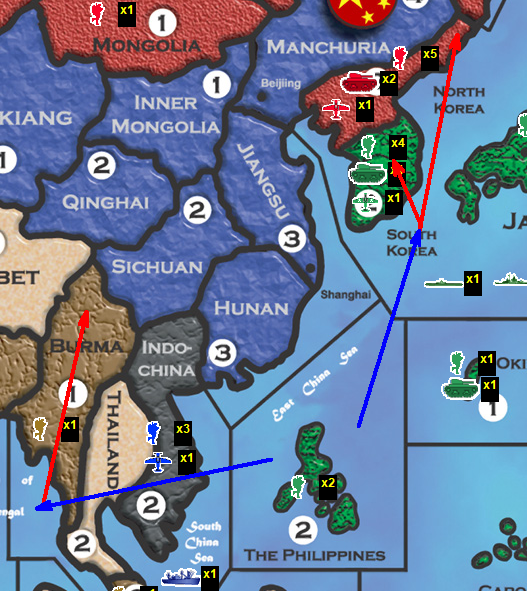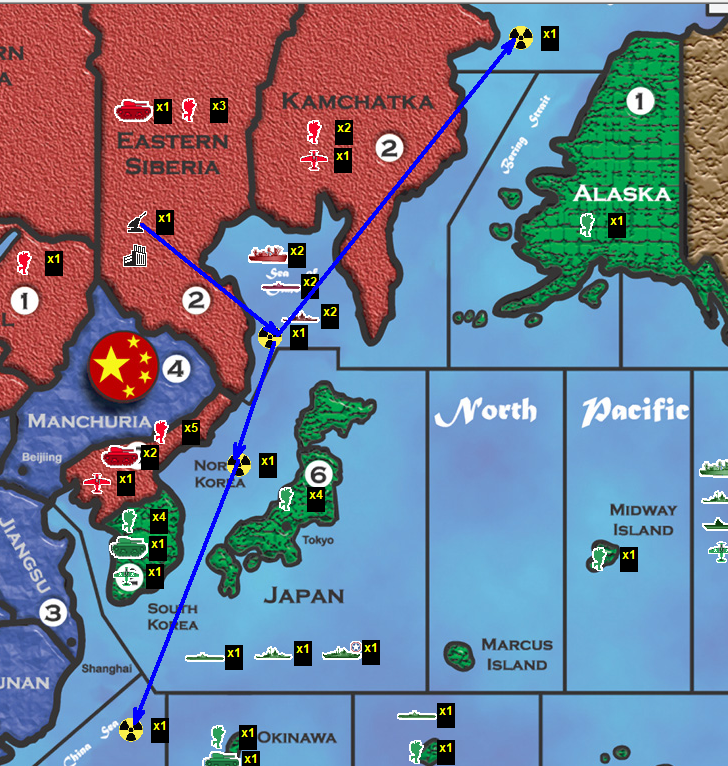Tactics: Japan IC vs. Philippines IC
Back in the old days, it was not uncommon to see the US player build an IC in Japan. In one of my games from earlier this year, however, I found myself placing an IC in the Philippines instead. I’ve done some more thinking about it since then, so I’d like to go into some depth about the pros and cons.

The simple geography paints this picture, for the Philippines IC:
Every round, you can “shuck-shuck” units built in the Philippines to either Burma or the Koreas. Since the Philippines is a 2-IPC territory, it would natively be able to produce 2 infantry every round (enough to fill 1 transport.) Adding an IC means you could produce 2 more units of any kind, which gives us a couple of distinct options for what to place there every round:
- 4 inf: costs 12 IPCs, fills 2 transports
- 2 inf, 2 arm: costs 16 IPCs, fills 3 transports
- 2 inf, 1 arm, 1 ftr: costs 23 IPCs, fills 2 transports
(Another thing to consider is that even if we’re only producing 1 arm/ftr/bmb in the Philippines per round, we’re still getting use out of that IC, so it’s adding some value. If it’s primarily supporting the UK in India, we want to build up some tanks for offense, so that we can eventually be in a position to attack.)
Now, let’s delve a little deeper into the economic situation, to figure out which of these options to consider.
It doesn’t make a ton of sense to exclusively build our Pacific units out of the Philippines; without an IC, Japan can produce 6 infantry every round – enough to fill 3 transports, at a cost of 18 IPCs.
I generally work from the assumption that the US will lose South Korea, and the USSR will be able to hold it for a round or so; this means we can expect the US to have a reliable income of 41 IPCs.
6 inf (Japan) = 18 IPCS
+
2 inf, 1 arm, 1 ftr (Philippines) = 23 IPCs
Total: 41 IPCs
This means that if we plan to produce these units every round as the US, we won’t have anything left to contribute to Europe.
The idea of producing a fighter every turn is that it can be used to defend India, since it has the movement to make it there in one turn. This is obviously not cheap, so let’s replace the fighter with a 2nd armor.
This leaves us with 7 IPCs to commit to Europe, which IMO is kind of the bare minimum; 7 IPCs is enough to fill one transport, using either an armor (say, from the Eastern US going to France) or 2 infantry (such as from Iceland, going to France, or somewhere along the Barents Sea.)
The trickiest part about going with 2 inf + 2 arm for the Philippines build, is that this requires 3 transports in order to move. Generally, the idea is that the US would spend rd1 building new transports, rd2 moving transports around and using them to collect starting infantry/armor, but by rd3 the shuck-shuck pipelines need to be in place.
Since the US starts with 3 transports in the Pacific (which can be filled by Japan all on its own) a strategy where the Philippines also needs 3 transports is going to take an extra round to set up. My general thinking is that you will want to use the Philippines IC to produce a transport on rd2, but otherwise its purpose should be to produce ground(/air) units – not navy.
So, if we’re only using 2 transports for the Philippines, and we’ve ruled out building a fighter, that reduces our options to producing 2 infantry or 1 armor there (plus the 2 inf base) every round – maybe even alternating between the two options. This means we’re spending 11 or 12 IPCs here, leaving 29-30 IPCs; after we factor in Japan’s placement (18 IPCs) we’re left with 11-12 IPCs. What this translates to is 4 infantry or 2 infantry and 1 armor for Europe.
(Another option, if the decision is made to only use 2 transports around the Philippines, is to build 2 armor there every round; this would tend to imply that they would always be sent to Korea, supported by infantry being sent from Japan.)
Chukchi Sea Pipeline

So this is what the geography dictates we could do, without building a new IC (in either Japan or the Philippines.) Essentially, if we want to put armor into the theatre, we can do this by using the shuck-shuck in to either Eastern Siberia or Kamchatka, every round:
- The reason to put an IC in Japan, is to put armor into Eastern Siberia, Kamchatka, or Korea every round
- The reason to put an IC in Philippines, is to put armor into Burma or Korea every round
Using this simple axiom, what becomes clear is that the Philippines IC extends the ranges to which we can project force, in a way that the Japan IC does not.
The other big mark against the Japan IC comes from the economics side of it:
- 12 inf: costs 36 IPCs, fills 6 transports
- 10 inf, 2 arm: costs 40 IPCs, fills 7 transports
- 6 inf, 6 arm: costs 48 IPCs, fills 9 transports
With the first option, we’re left with only 5 IPCs (i.e. 1 armor) to send to Europe.
The second option, we’re spending all of our income (save 1 IPC) cranking out units from Japan. These armor have to be going to Korea in order to make purchasing this IC even worth it – otherwise, we’re better off building armor in Western US. (The other thing to consider is, do we even need a Japan IC if/when we conquer Eastern Siberia?)
The third option, we’ve gone completely over budget trying to maximize production on Japan; keep in mind, as we take territories and gain IPCs, we can actually place infantry directly into those territories, making this new IC even less valuable as the game goes on – not more.
The other thing to consider is that by using the Japan IC, we’re not able to use our 2 infantry production capability from the Philippines; if we were to not put an IC in either territory, we could still fill 4 transports (with 8 infantry = 24 IPCs) every round, plus whatever we’re able to ship in from North America.
Nuclear Deterrence

The other reason to consider the Philippines IC, is in the case of the USSR developing nukes early in the game; with their free tech roll, this outcome is basically an inevitability. As we can see from above, a nuke meant to deter the US Pacific fleet would likely be built in Eastern Siberia, and have an effective range of 3 spaces (launched either from a bomber or by ballistic missile.)
This means that any shuck-shuck from Japan OR from North America is essentially ruined. Your opponent may not want to waste 20 IPCs to clear your fodder and leave you transports intact, but if the first nuke doesn’t get them, the second one will (or an upgraded nuke.)
If you base your entire Asia shuck-shuck around a Philippines IC supported by 3 transports, this means you’re moving 2 inf and 2 arm to Burma every round. Your transports end their turn in the Burma SZ, safely out of the range of most nukes (barring long-range aircraft.)
Countering Soviet Ambitions: Stopping the Domino Effect

Another move to consider is the one depicted here: moving an AA gun from the Philippines, to defend India.
(Yes, this will leave your transport out of position for a turn, but this can be mitigated a bit if you move the US transport from Italy out towards this direction.)
If the Soviets are going for an early India attack (like the one I have outlined in the “Operation: Underbelly” write-up) getting an AA gun to India on rd3 can do a lot to foil this plan, and tip the odds in NATO’s favour – since the attack is reliant on massing the entire Soviet air force.
On rd1, we can place an IC in the Philippines; on rd2, we can use the IC to produce an AA gun, and a transport with which to move it. This spares the UK from having to commit to an India IC build, just for the purposes of getting an AA gun in-theatre.
(As I’ve talked about before, the India IC removes a lot of the flexibility the UK potentially has, since they can easily spend all of their income just in this theatre. However, if the spectre of Soviet nukes in the early game is threatening the Atlantic fleet, the India IC becomes a more attractive pipeline for the UK getting boots on the ground.)
Overmatch Capability 
The other thing to consider in this theatre is the production capacity of the USSR; between Kamchatka, Eastern Siberia, and North Korea alone, they can put out 8 infantry per round.
This means that just to maintain parity, the US needs to commit a minimum of 4 transports to the theatre – enough to fill with infantry from Japan and the Philippines, every round. Of their 41 IPC budget, this would leave them another 17 IPCs to spend on units in North America, to send to either Europe or to Asia. This translates to 4 infantry and 1 armor – an additional 3 transport loads.
The case could be convincingly made that the US actually must spend all of their production in this theatre, in order to push back the Soviets.














